
The Night of the Hunter is a 1955 American film noir thriller directed by Charles Laughton and starring Robert Mitchum, Shelley Winters and Lillian Gish. The screenplay by James Agee was based on the 1953 novel of the same name by Davis Grubb. The plot involves a serial killer who poses as a preacher and charms an unsuspecting widow to get his hands on $10,000 in stolen bank loot hidden by her executed husband.

William Washington Beaudine was an American film director. He was one of Hollywood's most prolific directors, turning out films in remarkable numbers and in a wide variety of genres.

Nell Shipman was a Canadian actress, author, screenwriter, producer, director, animal rights activist and animal trainer. Her works often had autobiographical elements to them and reflected her passion for nature. She is best known for making a series of melodramatic adventure films based on the novels by American writer James Oliver Curwood in which she played the robust heroine known as the ‘girl from God’s country.'

Mom and Dad is a feature-length 1945 American film directed by William Beaudine, and largely produced by the exploitation film maker and presenter Kroger Babb. Mom and Dad is considered the most successful film within its genre of "sex hygiene" films. Although it faced numerous legal challenges and was condemned by the National Legion of Decency, it became one of the highest-grossing films of the 1940s.

Howard W. "Kroger" Babb was an American film producer and showman. His marketing techniques were similar to a travelling salesman's, with roots in the medicine show tradition. Self-described as "America's Fearless Young Showman", he is best known for his presentation of the 1945 exploitation film Mom and Dad, which was added to the National Film Registry of the Library of Congress in 2005.
Mildred Horn was an American film critic and screenwriter, best known for her work on the Kroger Babb exploitation film Mom and Dad.
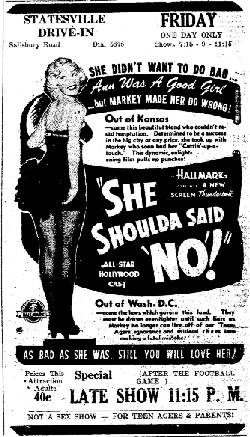
She Shoulda Said 'No'! is a 1949 exploitation film that follows in the spirit of morality tales such as the 1936 films Reefer Madness and Marihuana. Directed by Sam Newfield and starring Lila Leeds, it was originally produced to capitalize on the arrest of Leeds and Robert Mitchum on a charge of marijuana conspiracy.
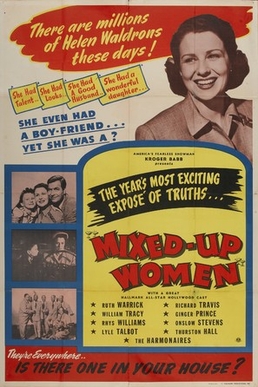
One Too Many is a 1950 film produced by Kroger Babb and directed by Erle C. Kenton. The film tells the story of Helen Mason, who is slowly revealed during the course of the film to be an alcoholic, destroying her career as a concert pianist and her family in the process.
William Nuelsen Witney was an American film and television director. He is best remembered for the action films he made for Republic Pictures, particularly serials: Dick Tracy Returns, G-Men vs. the Black Dragon, Daredevils of the Red Circle, Zorro's Fighting Legion, and Drums of Fu Manchu. Prolific and pugnacious, Witney began directing while still in his 20s, and continued working until 1982.
Judith Lee Baldwin is an American film and television actress. A life member of the Actors Studio, Baldwin amassed 46 screen credits between 1969 and her leading role in 2005's Every Secret Thing. In 1978, she replaced Tina Louise in the role of Ginger Grant in Rescue from Gilligan's Island. Baldwin reprised the role in The Castaways on Gilligan's Island the following year.
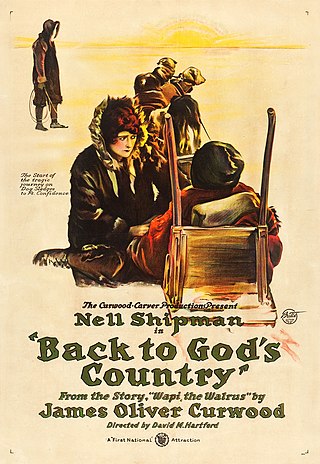
Back to God's Country is a 1919 Canadian drama film directed by David Hartford. It is one of the earliest Canadian feature films. The film starred and was co-written by Canadian actress Nell Shipman. With an estimated budget of over $67,000, it was the most successful silent film in Canadian history.

Kitty Foyle, subtitled The Natural History of a Woman, is a 1940 drama film starring Ginger Rogers, Dennis Morgan and James Craig, based on Christopher Morley's 1939 bestseller Kitty Foyle. Rogers won the Academy Award for Best Actress for her portrayal of the title character, and the dress she wore in the film became known as a Kitty Foyle dress.
Ginger Prince (1942-2015) was a child actress, best known for her roles in a handful of Hallmark Productions pictures. She starred in three of Kroger Babb's productions. She then returned to Atlanta, GA to host a radio program, "Ginger from Georgia".

Maude Eburne was a Canadian character actress of stage and screen, known for playing eccentric roles.

Misbehaving Husbands is a 1940 American comedy film directed by William Beaudine for Producers Releasing Corporation. The film had the working titles At Your Age and Dummy Husbands. Harry Langdon, Betty Blythe, Esther Muir, and others in the cast had been stars in silent films. It was Gig Young's film debut, under his real name Byron Barr.
William Hatfield (1892–1969) was the pen name of Ernest Chapman, an English-born writer best known for his work in Australia.

William Harris Ruhl was an American character actor of the 1930s, 1940s, and early 1950s.
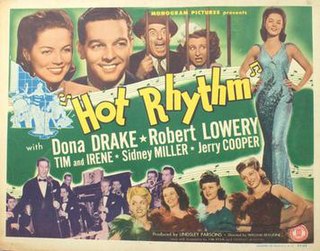
Hot Rhythm is a 1944 American musical comedy film directed by William Beaudine and starring Robert Lowery, Dona Drake, and the radio and vaudeville team of Tim and Irene.
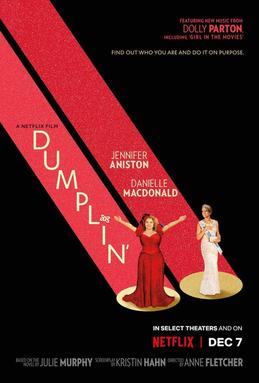
Dumplin' is a 2018 American coming-of-age comedy-drama film directed by Anne Fletcher and written by Kristin Hahn. It is based on the young adult novel of the same name by Julie Murphy. The film stars Danielle Macdonald as Willowdean "Dumplin'" Dickson, Jennifer Aniston as her mother, Rosie Dickson, and Odeya Rush as her best friend, Ellen Dryver.

Willa Pearl Curtis was an American actress in film and television. She was active in the Negro Motion Picture Players Association in Los Angeles.















